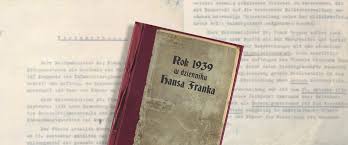“I wrote down the general account of the work done in this region since 1939 in the journals and stenographic notes of my speeches. This one of a kind documentation of work will forever remain as the testimony of the seriousness with which I took on the task given to me, as well as with how much zeal my valuable co-workers completed this task.”
Hans Frank’s statement written down in Krzeszowice, 28 VIII 1942
As cited in S. Piotrowski Sprawy polskie przed Międzynarodowym Trybunałem Wojennym w Norymberdze, Vol. I: Hans Frank’s Journal, Warsaw 1956, page 7
The General Government existed between the autumn of 1939 and spring of 1945 (until the summer of 1940 under the name General Government for the Occupied Polish Lands) and for the entirety of its existence it was led by Hans Frank. The German occupation of Poland brought countless sacrifices and suffering to Polish citizens, but Hans Frank’s vanity created a unique and priceless historical source of that time – a journal written between October 25th 1939 and April 3rd 1945 (until November 1st 1939 in Łódź, then in Cracow until January 17th 1945, and finally in Silesia and Bavaria).
The original copy of Frank’s journal counts 40 volumes (11 367 pages) and was written in the form of a one-side typescript (a transcript rewritten on a typewriter) with hand written and typed notes and corrections. Fundamentally, it consists of: 24 volumes of the diary of the General-Governor; 11 volumes of protocols and transcripts of sittings of various managing bodies and finally 5 volumes of indexes.
Following Hans Frank’s escape from the General Government to Bavaria, the journal became the property of the US army and ended up at the desk of the American General Prosecutor Investigating Axis Crimes. During the trials of the International Court Martial in Nuremberg it was used both by the defence and the prosecution. The journal then returned to Poland thanks to the initiative of Dr Stanisław Piotrowski (the Polish legal assistant of the Nuremberg prosecutors) with huge help from General Brigadier Telford Taylor (the assistant of the leading American prosecutor in the Nuremberg trials). Then, it was taken to Cracow in 1947 by the investigative judge for special matters Jan Sehn (the president of the District Commission for the Prosecution of Crimes against the Polish Nation). In order to do a photocopy, the diary was moved to Warsaw in 1952 – where, as it turned out, it stayed for good.
Reprints of parts of Hans Frank’s journal started being published soon after the war had ended. The Hans Frank’s Diary prepared for the Soviet and American prosecutors of the International Court Martial in Nuremberg by Stanisław Piotrowski was published by an unknown publisher from Leipzig (in German and Russian) already in 1945. Short fragments of the aforementioned Diary were first announced to be published in Polish by Edmund J. Osmańczyk (at the time a foreign correspondent for the Polish Radio) with the Publishing Company “Czytelnik” as well as Eugeniusz Szrojt (at the time a member of the Chief Commission for the Prosecution of Crimes against the Polish Nation) with the “Bulletin” of the Chief Commission. Parts of the journal also appeared in the official edition of the materials of the International Court Martial in Nuremberg called TRIAL or IMT.
Paweł Kosińsk
The full text is available here
i
